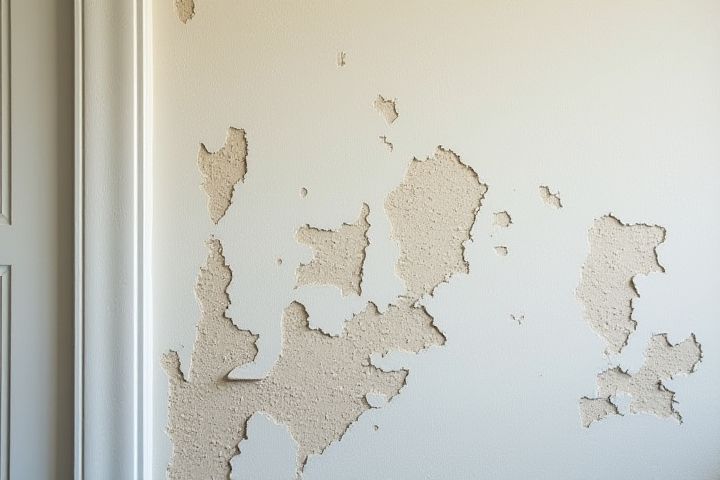
House paint peels for several reasons, primarily due to moisture infiltration, inadequate surface preparation, or the use of low-quality paint. When water seeps beneath the paint layer, it creates a pressure build-up that leads to bubbling and ultimately peeling. Poor surface preparation, such as failing to clean or sand the previous coat, prevents proper adhesion, causing the paint to lose its grip over time. In areas with extreme temperatures, the expansion and contraction of surfaces can also contribute to paint loss. Choosing high-quality paint and ensuring proper application can significantly reduce the risk of peeling and extend the life of your paint job.
Why House Paint Peels
Moisture infiltration
Moisture infiltration occurs when water permeates the walls and surfaces of your home, disrupting the bond between the paint and the substrate. Factors such as poor ventilation, leaks, or high humidity can cause excess moisture, leading to the formation of blisters under the paint. When paint trapping moisture dries, it loses its adhesion, resulting in unsightly peeling and flaking. To prevent this, ensure proper sealing, regular maintenance, and adequate airflow throughout your living spaces.
Poor surface preparation
Poor surface preparation is a leading cause of house paint peeling, contributing to up to 80% of paint failures. When surfaces are not cleaned properly, contaminants like dust, grease, and mildew can hinder paint adhesion. Inadequate priming can also create a weak bond, making it easier for moisture to infiltrate and lift the paint over time. To ensure long-lasting results, invest the time to thoroughly sand, wash, and prime surfaces before applying paint.
Low-quality paint
Low-quality paint can lead to peeling due to its inferior adhesion and durability. Comprising lower-grade binders and fillers, these paints struggle to bond with surfaces, especially in demanding environments. Environmental factors, such as humidity levels above 50% or drastic temperature fluctuations, can exacerbate the issue, causing the paint to expand and contract. Investing in high-quality paint not only enhances the aesthetic appeal of your home but also ensures longevity, sparing you the costs of frequent repainting, typically every 3-5 years with lower-quality options.
Incompatible paint layers
Incompatible paint layers are a primary cause of house paint peeling, as they can lead to poor adhesion between the layers. For example, applying a water-based paint over an oil-based paint without proper preparation can create a bond that is weak, often leading to flaking within months. The differing chemical compositions of these paints can also result in moisture being trapped, which exacerbates the peeling issue. Ensuring compatibility by using the same type of paint or utilizing a suitable primer can significantly enhance the durability and lifespan of your paint job.
Applying paint in humid conditions
Applying house paint in humid conditions can lead to premature peeling due to moisture trapped between the surface and the paint layer. High humidity levels, often exceeding 70%, can prevent proper adhesion, causing the paint to lose its bond with the substrate. This moisture can also lead to the formation of mildew and mold, further compromising the integrity of the paint finish. To ensure longevity, it's crucial to monitor humidity levels and choose a suitable time for painting, ideally when relative humidity is below 50%.
Excessive sunlight exposure
Excessive sunlight exposure significantly contributes to house paint peeling, particularly in areas that receive direct UV rays for prolonged periods. UV radiation breaks down the chemical bonds in paint, causing it to lose its adhesion properties and eventually crack or flake off. In regions where sunlight intensity averages over 5 hours daily, the risk of peeling increases dramatically, especially if the paint is not formulated for high UV resistance. To maintain your home's aesthetic and protect its surfaces, consider using paint specifically designed for high-exposure environments to enhance durability.
Lack of primer
Peeling house paint often results from a lack of primer, as primer serves to create a strong bond between the surface and the paint. Without it, the paint may not adhere properly, leading to moisture infiltration and gradual deterioration. For optimal results, ensure that you apply a quality primer tailored to your specific surface--wood, metal, or drywall--before painting. Taking this essential step can significantly enhance the longevity and appearance of your painted surfaces.
Painting over dirty surfaces
Peeling house paint often occurs when applied over dirty surfaces, as contaminants like dust, grease, or mildew create a barrier that prevents proper adhesion. When these surfaces are not adequately cleaned, the paint cannot bond effectively, leading to premature failure and delamination. Proper surface preparation is crucial; washing, scraping, and priming ensure the underlying material is free from debris and moisture. Maintaining your home's exterior with regular cleaning can significantly extend the life of your paint job and enhance its appearance.
Temperature fluctuations
Temperature fluctuations can significantly contribute to house paint peeling, as these changes create expansion and contraction in the paint layer. Extreme temperatures cause the underlying building materials to shift, leading to a breakdown of the adhesion between the paint and the surface. For instance, if the temperature consistently swings between hot and cold, the paint may lose its elasticity, resulting in cracks and eventual detachment. Maintaining a consistent environment and applying high-quality, temperature-resistant paints can help mitigate these issues.
Inadequate drying time
Inadequate drying time is a primary factor in house paint peeling, often resulting from applying coats too quickly without allowing the previous layer to cure properly. Paint typically requires 24 hours to dry between coats, but poor ventilation or high humidity can extend this duration significantly. When the underlying layer remains damp, moisture can force its way to the surface, causing the paint to lift and peel. Ensuring proper drying conditions can substantially enhance the longevity and performance of your paint job.
